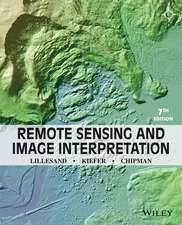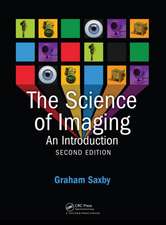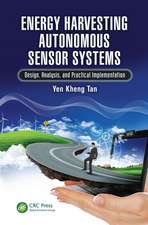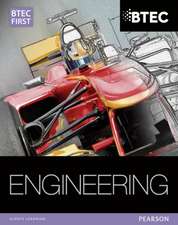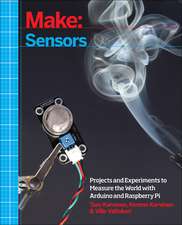Interactive Image Processing for Machine Vision
Autor Bruce G. Batchelor, Frederick Waltzen Limba Engleză Hardback – 30 mar 1993
| Toate formatele și edițiile | Preț | Express |
|---|---|---|
| Paperback (1) | 949.55 lei 6-8 săpt. | |
| SPRINGER LONDON – 5 oct 2012 | 949.55 lei 6-8 săpt. | |
| Hardback (1) | 955.88 lei 6-8 săpt. | |
| SPRINGER LONDON – 30 mar 1993 | 955.88 lei 6-8 săpt. |
Preț: 955.88 lei
Preț vechi: 1165.70 lei
-18% Nou
Puncte Express: 1434
Preț estimativ în valută:
182.91€ • 191.85$ • 152.27£
182.91€ • 191.85$ • 152.27£
Carte tipărită la comandă
Livrare economică 01-15 aprilie
Preluare comenzi: 021 569.72.76
Specificații
ISBN-13: 9783540198147
ISBN-10: 3540198148
Pagini: 408
Ilustrații: XVII, 385 p.
Dimensiuni: 155 x 235 x 22 mm
Greutate: 0.74 kg
Ediția:1993
Editura: SPRINGER LONDON
Colecția Springer
Locul publicării:London, United Kingdom
ISBN-10: 3540198148
Pagini: 408
Ilustrații: XVII, 385 p.
Dimensiuni: 155 x 235 x 22 mm
Greutate: 0.74 kg
Ediția:1993
Editura: SPRINGER LONDON
Colecția Springer
Locul publicării:London, United Kingdom
Public țintă
ResearchDescriere
Machine vision systems offer great potential in a large number of areas of manufacturing industry and are used principally for Automated Visual Inspection and Robot Vision. This publication presents the state of the art in image processing. It discusses techniques which have been developed for designing machines for use in industrial inspection and robot control, putting the emphasis on software and algorithms. A comprehensive set of image processing subroutines, which together form the basic vocabulary for the versatile image processing language IIPL, is presented. This language has proved to be extremely effective, working as a design tool, in solving numerous practical inspection problems. The merging of this language with Prolog provides an even more powerful facility which retains the benefits of human and machine intelligence. The authors bring together the practical experience and the picture material from a leading industrial research laboratory and the mathematical foundations necessary to understand and apply concepts in image processing. Interactive Image Processing is a self-contained reference book that can also be used in graduate level courses in electrical engineering, computer science and physics.
Cuprins
1 Setting the Scene.- 1.1 Human and Animal Vision.- 1.2 Machine Vision.- 1.2.1 Machine Vision Functions.- 1.3 Applications of Image Processing.- 1.3.1 Health Services.- 1.3.2 Security and Forensic Science.- 1.3.3 Military.- 1.3.4 Commercial.- 1.3.5 Industrial.- 1.3.6 Earth Resources.- 1.3.7 Entertainment and Leisure.- 1.3.8 Domestic.- 1.3.9 Broadcast Television.- 1.3.10 Agriculture and Food.- 1.3.11 Communications.- 1.3.12 Education and Training.- 1.3.13 Service Industry, Transport.- 1.3.14 Research.- 1.4 Problems of System Design.- 1.4.1 Simplifying the Task.- 1.4.2 A Warning.- 1.4.3 Non-Industrial Image Processing.- 1.5 Interactive Image Processing (IIP).- 1.6 Practical Uses of Interactive Image Processing.- 1.7 Purpose and Outline of This Book.- 2 Principles of Digital Image Processing.- 2.1 Digital Representations of Images.- 2.1.1 Monochrome (Grey-Scale) Images.- 2.1.2 Binary Images.- 2.1.3 Color and Multispectral Images.- 2.1.4 Stereoscopic Image Pairs.- 2.1.5 Moving Images.- 2.2 Processing Functions.- 2.2.1 Notation.- 2.2.2 Monadic Point-by-Point Operators.- 2.2.3 Dyadic Point-by-Point Operators.- 2.2.4 Local Operators.- 2.2.4.1 Linear Local Operators.- 2.2.4.2 Non-Linear Local Operators.- 2.2.4.3 Using Direction Codes.- 2.2.5 n-tuple Operators.- 2.2.6 Edge effects.- 2.2.7 Global Image Transforms.- 2.2.8 Geometric Transforms.- 2.3 Binary Images.- 2.3.1 Measurements on Binary Images.- 2.4. Commentary.- 3 Syntax of IIPL.- 3.1 Introduction.- 3.2 Basic Commands.- 3.3 Command Sequences.- 3.4 Registers.- 3.5 Looping, Jumps, and Conditional Jumps.- 3.6 Macros.- 3.6.1 Macro Names.- 3.6.2 Macros Take Precedence Over Basic Commands.- 3.6.3 Programming Style.- 3.6.4 Macro Arguments, Numeric Values.- 3.6.5 Macros Incorporating Other Macros.- 3.6.6 Macro Arguments Generalized.- 3.6.7 Recursion.- 3.6.8 Library and User-Defined Macros.- 3.6.9 Further Remarks Relating to Macros.- 3.7 Histogram Buffer.- 3.8 Character Strings.- 3.9 Miscellaneous Control Features.- 3.10 Calling User-Defined Functions.- 3.11 Discussion and Summary.- 3.11.1 Choice of Mnemonic Form.- 3.11.2 Repertoire of Basic Commands.- 3.11.3 History, Variations on a Theme.- 3.11.4 Résumé.- 3.12 Addendum.- 3.12.1 Incorporating Basic-Like Features into IIPL.- 3.13 Prolog+, Merging Prolog with IIPL.- 4 Practical Considerations.- 4.1 Workstation Layout.- 4.1.2 Ergonomic Factors.- 4.1.3 System Response Times.- 4.1.4 Recording Results.- 4.2 Extending the Scope of IIPL.- 4.2.1 Controlling Dedicated Image Processing Hardware.- 4.3 Adding a Processor to Control the IIP.- 4.4 Using a Journal to Generate Macros.- 4.5 Can We Use AI Techniques to Guide the IIPL User?.- 4.6 Generating Software for Target Systems.- 4.7 Hardware-Based Versions of IIPL.- 4.7.1 IIPL/H System 1: A Basic System.- 4.7.2 IIPL/H System: Added Capabilities.- 4.7.3 IIPL/H System 3: A System for Desktop Computers.- 4.7.4 Status of IIPL/H Implementations.- 4.8 Menu Selection of Commands.- 4.9 Using a Mouse in IIPL.- 4.10 Pseudo-Color.- 4.11 Conclusions.- 5 Applications Case Studies.- 5.1 Crack Detection in Metal Components.- 5.2 Robotic Manipulation of Objects.- 5.3 Form Measurement of Glassware (Bottle).- 5.4 Examination of Aerosol Sprays.- 5.5 Examination of Paint Work.- 5.6 Inspecting Factory-Made Cakes.- 5.7 Inspection of the Cap of an Electric Light Bulb.- 5.8 Measurement of Coiling of a Helical Lamp Filament.- 5.9 Detecting Glass Flakes.- 5.10 Locating the Ends of Floppy Serpentine Objects.- 5.11 Verifying the Existence of a Chamfer.- 5.12 Inspecting Non-Populated Printed Circuit Boards.- 5.13 Checking the Roundness of Fruit.- 5.14 Reading Punched Lettering on a Metal Surface.- 5.15 Identifying a Playing Card.- 5.16 Determining the Orientation and Pitch of a Grid.- 5.17 Existential Inspection of Internal Threads.- 5.18 Processing Laser Scanner Data of Metal Surfaces.- 5.19 Checking LCD Displays.- 5.20 Aligning Teeth on a Gear.- 5.21 Determining Hardness of aMetal Surface.- 5.22 Counting Diskettes in a Cardboard Box.- 5.23 Deciding on the Toss of a Coin.- 5.24 Counting the Teeth on a Rubber Belt.- 5.25 Calibrating a Spirit Level.- 6 Integrating IIPLwith Prolog.- 6.1 Introduction.- 6.1.1 Predicates.- 6.1.2 Facts.- 6.1.3 Queries.- 6.1.4 Rules.- 6.1.5 Back-Tracking.- 6.1.6 Recursion.- 6.1.7 Lists.- 6.1.8 Built-in Predicates.- 6.2 Earlier Attempts to Combine Prolog and Image Processing.- 6.3 Specification of Prolog+.- 6.3.1 Syntax.- 6.3.2 Accommodating IIPL Commands with No Arguments.- 6.3.3 Accommodating IIPL Commands with Arguments.- 6.3.4 Passing Parameters Follows Normal Conventions.- 6.3.5 Interactive Operation of Prolog+.- 6.3.6 Prolog+ Rules Replace IIPL Macros.- 6.3.7 Program Control.- 6.3.8 Predicates for Controlling Other Devices.- 6.4 Some Applications.- 6.5 Implementation of Prolog+.- 6.6 Discussion.- 7 In Conclusion.- 7.1 A Seeing Is Worth 10,000 Tellings.- 7.2 Alternative Modes of Interactive Image Processing.- 7.2 Future Prospects.- References.- Table of IIPL Basic Commands.





